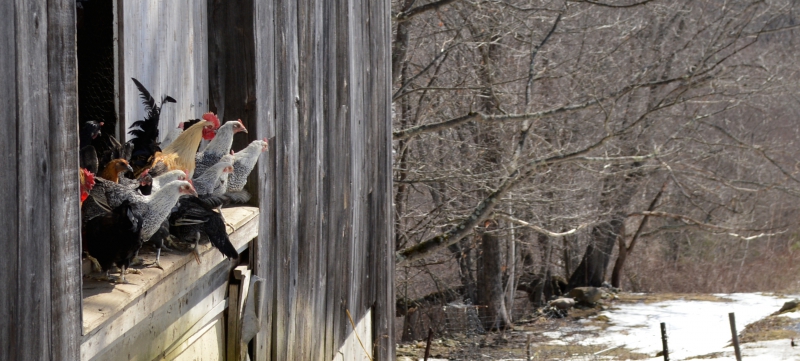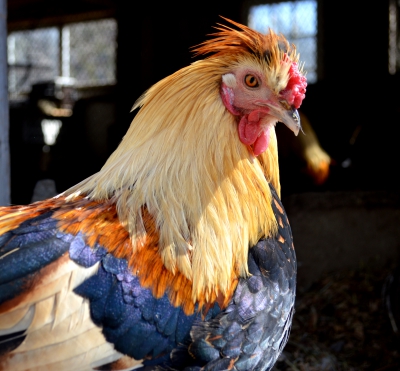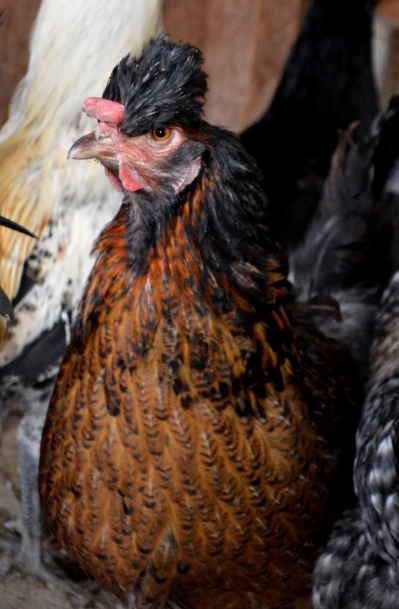By Erica Ludlow Bowman
Collectors come in many colors. They are humble hobbyists and erudite enthusiasts, gatherers of festive pants, cultivators of fancy plants, and all that comes between. At Taft Hill Farm in Windham, Vermont, they are keepers of the genus Gallus. Their flocks are descendants of the junglefowl, close relatives of the original chickens. They are in a league of their own.
As curator of Taft Hill Farm in Windham, Vermont, it’s Kermit Blackwood’s job to maintain the stewardship of “cultural heritage and cultural monument” lines of chicken landraces and breeds. It is also his responsibility to help educate people about their lineage and significance in the context of sustainable agriculture. “To be a chicken collector,” Blackwood says, “is to be a cultural historian.” The story of these traditional chickens is completely aligned with the story of the human experience.
It’s reasonable, Blackwood explains, to correlate events in the history of the domestication of the chicken to trends in maritime trading, culture, and human migration. Take, for example, the Bekisar, hybrid of the red junglefowl from the Vietnam region and green junglefowl from the Lesser Sundas Islands. Its hybridized traits included a sea-worthy drought tolerance and an unusual, rhythmic crow that could be heard over crashing waves. Early Polynesian voyagers hoisted the Bekisar roosters in baskets on poles so that they could help with navigation. Their strange crow announced flying birds, indicative of jet streams, and provided audible signals to keep the convoy together. By way of trade routes, Bekisars were spread along the Pacific. Its descendants lay the green tinted eggs.
Similarly, Blackwood relays a “suspicion” among ethnographers that the Chinese had been first to arrive in Mexico (before the Europeans). This is based on the prior existence of a peculiar “black-boned” breed of chicken called the Huastec or Mexican silkie, which is clearly related to the Chinese silkie but unknown to the Polynesians or South Americans. Black-boned fowl were developed in ancient Eastern Asia for medicinal purposes thousands of years before Europeans knew of them.
Telltale traits of chicken breeds can even revive forgotten histories, Blackwood adds. Consider the Lakenvelder chickens, attributed to the country of Germany but not to the Jewish culture that developed and perfected them. They were, in fact, developed by peoples of the Levant, the first culture to select and breed chickens specifically for egg production and incorporate eggs into dough. After the Holocaust, credit for the breed seemed to have been mislaid but the significance of this ancient breed as an egg producer lives on.
The chickens of Taft Hill Farm are developing their own cultural history. Originating from lines that existed before the evolution of industrial farming in Europe and America, these birds are descendants of indigenous, semi-domestic fowl from Indonesia, Easter Island and western South America. They are genetically inclined to survive, perpetuate, and produce eggs and meat in harsh, predator-filled environments, making them appropriate for Vermont farms.
The collection began with a few “founder’s flocks” from Japanese-American enthusiasts, including Dr. Richard Yamamoto, for whom Blackwood had worked as a teenager. Amazingly, a few extremely rare lines of Indonesian and South American Heritage breeds survived Dr. Yamamoto’s incarceration in an internment camp during World War II, thanks to the care of some Dutch friends. After internment, Dr. Yamamoto and other Japanese-American chicken collectors continued trading and imported new varieties though Hawaii and Peru. Eventually birds were combined with those of another collector by the name of Mr. Iwamiya, a trainer of stewards. Eventually, as each of the original collectors grew old, they bequeathed their birds and passed the stewardship of many of their lines to Blackwood.
Together with farm owners, Kathy and Robert DuGrenier, Blackwood has been developing a New Heritage breed called Sugarbush. This new bird is comprised of an intentional cross between the royal, long-tailed, Japanese breed, Onagadori and aChilean/Mexican silkie compositecalled Mapuche-Huastec. This strain was carefully bred for several years in a closed flock. Recently, they added a new line into the Sugarbush by introducing a handful of cockerels from a strain produced by local farmer, Albert Litchfield; a cross between his prize Swiss Spitzhauben rooster and a Mapuche-Huastec hen from Taft Hill. The offspring was bred with Old Egyptian Fayoumi hens. Four years later, after select breeding between these strains and natural selection from climate and predators, the Sugarbush is nearly its own New Heritage breed. Once fully established, they may become one of a very few livestock breeds unique to Vermont.
























































